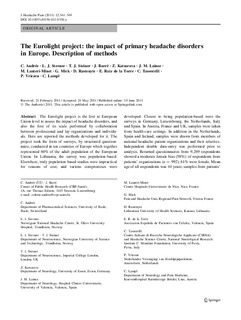| dc.contributor.author | Andree, Colette | |
| dc.contributor.author | Stovner, Lars Jacob | |
| dc.contributor.author | Steiner, Timothy J. | |
| dc.contributor.author | Barre, Jessica | |
| dc.contributor.author | Katsarava, Zaza | |
| dc.contributor.author | Lainez, Jose Miguel | |
| dc.contributor.author | Lanteri-Minet, Michel | |
| dc.contributor.author | Mick, Gerard | |
| dc.contributor.author | Rastenyte, Daiva | |
| dc.contributor.author | Torre, R. De La | |
| dc.contributor.author | Tassorelli, Cristina | |
| dc.contributor.author | Vriezen, Peter | |
| dc.contributor.author | Lampl, Christian | |
| dc.date.accessioned | 2019-10-10T09:39:08Z | |
| dc.date.available | 2019-10-10T09:39:08Z | |
| dc.date.created | 2011-09-20T17:03:28Z | |
| dc.date.issued | 2011 | |
| dc.identifier.citation | The Journal of Headache and Pain. 2011, 12 (5), 541-549. | nb_NO |
| dc.identifier.issn | 1129-2369 | |
| dc.identifier.uri | http://hdl.handle.net/11250/2621350 | |
| dc.description.abstract | The Eurolight project is the first at European Union level to assess the impact of headache disorders, and also the first of its scale performed by collaboration between professional and lay organizations and individuals. Here are reported the methods developed for it. The project took the form of surveys, by structured questionnaire, conducted in ten countries of Europe which together represented 60% of the adult population of the European Union. In Lithuania, the survey was population-based. Elsewhere, truly population-based studies were impractical for reasons of cost, and various compromises were developed. Closest to being population-based were the surveys in Germany, Luxembourg, the Netherlands, Italy and Spain. In Austria, France and UK, samples were taken from health-care settings. In addition in the Netherlands, Spain and Ireland, samples were drawn from members of national headache patient organizations and their relatives. Independent double data-entry was performed prior to analysis. Returned questionnaires from 9,269 respondents showed a moderate female bias (58%); of respondents from patients’ organizations (n = 992), 61% were female. Mean age of all respondents was 44 years; samples from patients’ organizations were slightly older (mean 47 years). The different sampling methods worked with differing degrees of effectiveness, as evidenced by the responder-rates, which varied from 10.8 to 90.7%. In the more population-based surveys, responder-rates varied from 11.3 to 58.8%. We conclude that the methodology, although with differences born of necessity in the ten countries, was sound overall, and will provide robust data on the public ill-health that results from headache in Europe. | nb_NO |
| dc.language.iso | eng | nb_NO |
| dc.publisher | BioMed Central | nb_NO |
| dc.rights | Navngivelse 4.0 Internasjonal | * |
| dc.rights.uri | http://creativecommons.org/licenses/by/4.0/deed.no | * |
| dc.title | The Eurolight project: the impact of primary headache disorders in Europe. Description of methods | nb_NO |
| dc.type | Journal article | nb_NO |
| dc.type | Peer reviewed | nb_NO |
| dc.description.version | publishedVersion | nb_NO |
| dc.source.pagenumber | 541-549 | nb_NO |
| dc.source.volume | 12 | nb_NO |
| dc.source.journal | The Journal of Headache and Pain | nb_NO |
| dc.source.issue | 5 | nb_NO |
| dc.identifier.doi | 10.1007/s10194-011-0356-y | |
| dc.identifier.cristin | 840665 | |
| dc.description.localcode | Open Access This article is distributed under the terms of the Creative Commons Attribution 2.0 International License (https://creativecommons.org/licenses/by/2.0), which permits unrestricted use, distribution, and reproduction in any medium, provided the original work is properly cited. | nb_NO |
| cristin.unitcode | 194,65,30,0 | |
| cristin.unitcode | 1920,16,0,0 | |
| cristin.unitname | Institutt for nevromedisin og bevegelsesvitenskap | |
| cristin.unitname | Nevroklinikken | |
| cristin.ispublished | true | |
| cristin.fulltext | original | |
| cristin.qualitycode | 1 | |

